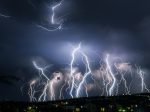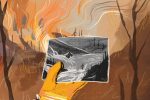The immediate danger posed by wildfires likely falls at the bottom of the average New Jerseyan’s list of concerns. The problematic crowds of the Jersey Shore and traffic on the New Jersey Turnpike are more realistic challenges for the 9 million people who call the Garden State home, yet this July offered a new threat that is typically associated with America’s other coast. Ash produced by fires in California and the Pacific Northwest blew across the continental United States, settling over the Eastern Seaboard just long enough to notably tarnish the air quality.
Mid-Atlantic states were issued health advisories meant to protect residents with health complications that could be adversely impacted by the smog. The latter half of 2020 saw a similar weather pattern bring problematic levels of smoke to East Coast skies, and with climate change unchecked and few regulations in place, these two unfortunate seasons might just represent the new normal.
A nightmare era of ever-present wildfires would not only decimate the Western land they clear but cause continued problems for residents of New Jersey and its neighboring states. It is easy to recognize the danger that wildfire ash poses to asthmatics or those with other respiratory conditions, yet the worsened air quality can also have dramatic effects on perfectly healthy individuals. Currently, the most well-understood problem with the affected air in cities such as New York is the presence of fine particles, scientifically labeled PM2.5 to indicate their size; these tiny particles trigger prolonged immune responses when inhaled, making them dangerous to sick and healthy people alike.
The danger of wildfire smoke becomes even more pronounced in consideration of its metallic composition, which could include lead and several other unknown elements. Severely diminished air quality is the foremost concern for most of the country, yet the ecosystems through which the fires spread often show the most prolonged scars. The removal of plant life can manipulate bodies of water to a degree whereby excess volume can cause flooding.
Local animal life is also drastically affected, with many endemic species being pushed further toward the brink of extinction by the flames and ground erosion that alter the symbiotic relationships within forested areas. Together, environmental decay and air pollution account for a set of problems that span the contiguous United States, yet the task of preventing this dangerous trend falls to a scarily small population of people.
The current efforts to combat extensive wildfire damage come from coordinated operations between various local and federal agencies. While local fire departments might appear to be the most suitable candidates to fight the blazes, the geography of the affected terrain and the resources that individual municipalities can muster renders smaller departments largely ineffective. The largest fires occur in overwhelmingly forested, sparsely populated regions, meaning that a department might be located far from a hotspot and have too few firefighters on-site to respond.
The U.S. Department of Agriculture’s Forest Service is the highest governing body that coordinates fire containment efforts, sending out crews of highly trained professionals to undertake preventative measures in the air and on the ground. There are roughly 10,000 fire crew members dispatched to contain the blazes each year, a number rendered inadequate because of the incomprehensibly large scale of the fires. As of Aug. 1, three million acres of U.S. land have burned, a drastic increase when compared to the 2.1 million acres that burned during the first seven months of 2020. Even for the most skilled professionals, reversing this growth is a tall order.
The contribution of smoke and ash to the atmosphere is significant, though wildfires are most remarkably consequential because of what they take away. Greenville, California, was formerly a sleepy but picturesque mountain community; it is now a ghost town. The state’s ravenous Dixie Fire has leveled Greenville into a burnt husk of its former self, leaving residents without homes and prompting a mass evacuation of the surrounding area. Extensive warnings remain necessary for the Dixie Fire because it is currently an uncontained blaze that has already spread across almost 400,000 acres of land. Its magnitude is great, but even the most extensive wildfires typically start from minute incidents.
Utility company Pacific Gas and Electric is currently believed to have started the Dixie Fire after a tree collapsed onto the company’s electrical infrastructure in the region. The blaze’s humble beginnings point to the great danger posed by small and easily fixable mistakes. The Northern California wilderness is riddled with coniferous trees that unfortunately accelerate the rate of burning, turning the job of containing an initially small fire into a battle against the clock. The burned signage for a Greenville church ironically captured the apocalyptic nature of the predicament, proclaiming, “The time is fulfilled, and the kingdom of God is at hand.”
This biblical scripture might paint a comprehensive picture of the end times, but it certainly fails to address the intricacies of climate change that allow the rapturous flames of the Dixie Fire to proliferate. The acceleration of the greenhouse effect has artificially increased average temperatures and reduced humidity in vegetated areas, creating conditions that are favorable to fires of both natural and human origin. Jim Randerson, a researcher at the University of California, Irvine, studied the frequency of lightning strikes during a wildfire season and found that the warmer temperatures directly increased the number of thunderstorms over the studied area.
Lightning is a common cause of wildfires, though as the Dixie Fire demonstrates, human error can work in tandem with natural conditions to start blazes. Crumbling infrastructure and mismanagement of recreational fires are compounded by the warmer temperatures that remove water from plant life in hotspot areas. These effects are felt most intensely in regions of the country that have naturally high average air temperatures and low humidity, effectively prolonging the period in which the risk of fires is heightened.
It is convenient to dismiss wildfires as an unfortunate downside of residing in California, but recent summers have demonstrated that Americans shouldn’t view them as exclusive to the Golden State. Fires have cropped up in record numbers not just within the boundaries of California, but across the Pacific Northwest, Western Canada and Europe. Heat waves in British Columbia have caused similar damage throughout the region, raising concerns that droughts in other provinces including Manitoba may facilitate flareups of wildfire activity across the country.
Despite being far north of the American regions that are prone to the wildfire epidemic, the provinces of Canada that are now seeing increased fire activity share similar vegetation and weather patterns. A brief look at the Environmental Protection Agency’s AirNow interactive map displays another frightening development: increased wildfire activity on the edge of the Midwest.
What the Dakota plains lack in excessive foliage they make up for with the same cocktail of rising temperatures and low humidity that has plagued California and the Pacific Northwest. The geographical range over which the wildfire season now occurs is consistently growing, and it might not be long until residents of New Jersey must contend with more than just residual smoke.
It has been historically accurate to describe the annual period in which wildfires are common a season, yet this distinction runs the risk of normalizing the fundamentally abnormal circumstances that the past few years have presented. The rise in temperatures shows no sign of stopping, and without significant global coordination to address climate change, the season in which fires are prevalent will begin to occupy most of the calendar year.
Fortunately, many companies have become increasingly interested in taking preventative measures against wildfires after experiencing financial losses. The extensive lumber industry in the Western United States is entirely dependent upon harvesting the material that is being engulfed by the blazes. Utility companies are now considering reworking their infrastructure so that it is out of harm’s way while also minimizing the likelihood that it will start a fire of its own.
It is promising to see companies that are affected by wildfires take proactive measures, yet the acceleration of the greenhouse effect responsible for the larger problem requires government regulation that has not yet been effectively implemented. Only through the resolution of political differences and a uniform effort to minimize emissions can the blazes that are consuming the North American continent be extinguished.

















